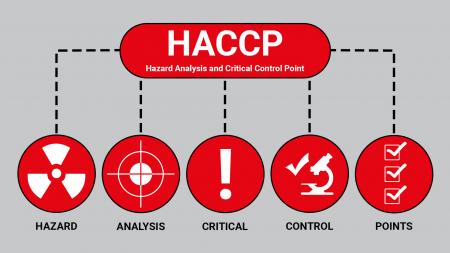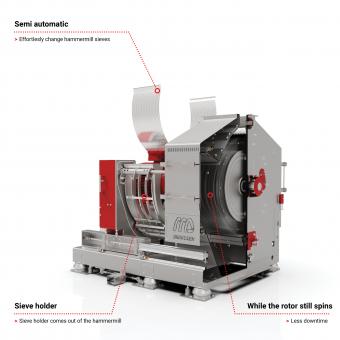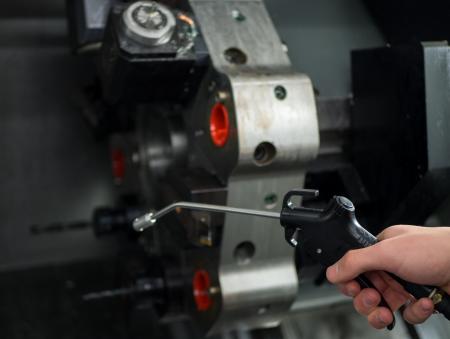Working in a hygienic manner is of the utmost importance In the food industry.
Without the right hygienic conditions it is not possible to produce food products that can be used safely by the consumer. Ensuring that production processes are and remain suitable for the production of food products is laid down in standards. This article discusses a number of essential themes within the existing guidelines. The following six topics are covered:
- Regulations
- Food production process and risk analysis
- Cleaning technology - cleaning - disinfection - hygiene
- HACCP - Hazard Analysis and Critical Control Points
- EHEDG - Validation cleaning process
- EHEDG guidelines versus HACCP
The experts at Dinnissen Process Technology are available to answer all your questions:
Get in touch with Juul Jenneskens 077 467 3555
Regulations
It is very important for consumers that food is produced hygienically. Therefore the food industry has to adhere to certain regulations. In practise however you can find examples of situations where the rules of a clean and clean production process are not followed.
The starting point for a safe product is first and foremost regular and thorough cleaning of the production equipment. The design of the machines and equipment and the organisation of the production process are partly decisive for achieving the desired and necessary cleaning level. The entire production line must be able to be cleaned thoroughly in an efficient manner.
National and international legislation and various internationally operating bodies are engaged in the development of guidelines to achieve guaranteed safe food production. European legislation is decisive for Europe. National governments follow this European policy. The European Hygienic Engineering and Design Group (EHEDG), the U.S. The Food and Drug Administration (FDA) and the World Health Organisation (WHO) are three important and influential organisations that set rules for the hygienic production of foods and their validation. Later in this article, the guidelines on safeguarding the cleaning and disinfection processes are discussed. First of all, the Hazard Analysis and Critical Control Points (HACCP) are discussed, which have been specially developed for companies active in the food sector. After that you can find an explanation about how processes in the food industry are validated if the EHEDG system is followed.

HACCP
Food production process and risk analysis
The food production process involves one or more of the following operations:
- Separating food into multiple parts,
- Combining various components,
- The conversion of constituents to a new form,
- The transport between the various process steps.
In these process steps it is important to reduce the risks of contamination and to increase the expiry date. A clean and pleasant environment makes a significant contribution to this risk reduction. The start of clean food production starts with an inventory of the risks. The following types of contamination can occur when working with foodstuffs:
- Organic, think of microorganisms or vermin,
- Chemical, think of cleaning agents or lubricants,
- Physical, think of stones or broken machine parts.
Later in this article, attention is paid to the risk inventory applicable to the food industry.

Clean machine
Cleaning technology
Cleaning
Cleaning machines and equipment means that dirt must be removed. This can be biological, chemical or physical contamination. Sometimes the contamination sticks to a relatively smooth surface and the dirt can be removed by rubbing with a damp cloth. In this situation it is sometimes also possible to dissolve the dirt by immersing the contaminated surface in a liquid containing soap. Cleaning is more difficult if a surface is not flat. Cleaning is also more difficult if the surface is rough or damaged or if there are small openings or pores in it.
The choice of the right cleaning agent is of utmost importance. Thorough knowledge is required about the solubility of the contamination that occurs in various chemical liquids. Cleaning substances need to be applied in the manner indicated in the regulations. Other important factors for a good cleaning are the cleaning power, the temperature of the cleaning and the duration of cleaning. High-pressure cleaning, foam cleaning and cleaning with dry ice are common in the food industry.
Disinfection
Disinfection is the killing of microorganisms, especially bacteria that can cause infection in the foodstuffs to be produced. Before disinfection can be started, it must first be thoroughly cleaned. The areas to be disinfected must be clean, dry and free from organic or chemical particles adhering to them. Disinfection is generally done thermally or chemically. These two techniques can also be used simultaneously.
Hygiene
Cleaning and disinfection are therefore not two words for the same concept. Disinfection kills microorganisms, while cleaning is aimed at removing dirt.
A common definition for the concept of hygiene is the collection of all actions and treatments that ensure that humans and animals remain healthy by keeping them away from pathogens or isolating sources of contamination.

Cleaning a machine
The design of the machines and equipment and the structure of the production process are partly decisive for achieving the desired and necessary cleaning level
HACCP – Hazard Analysis and Critical Control Points
The HACCP has been developed especially for companies active in the production of foodstuffs. The most common activities of these types of companies are preparation, processing, transport and distribution of raw materials, semi-finished and finished products. HACCP is a directive set up by the European Union intended for all those companies that are active in the aforementioned areas. Working in accordance with this guideline must ensure that the risk of contamination and infections by micro-organisms in all steps of food production is kept as small as possible.
Via the HACCP, companies are offered the opportunity to determine in a structured manner where the greatest health risks can arise in the process and how these can then be kept within bounds. The inventory structure of the HACCP is structured as follows:
- Inventory of all potential dangers,
- Addition of the Critical Control Points (CCPs). These critical management points determine where in the process risks can be reduced or prevented,
- Indication of the critical limits per CCP,
- Determining how the CCPs should be monitored or "monitored",
- Determining per CCP what the corrective actions are that should lead to restoration of security,
- Periodically checking whether the HACCP approach is working properly,
- Recording the registrations and the (details of the) adjustments.
EHEDG - Validation of the cleaning process
The EHEDG has developed a guideline for validating processes, procedures and methods especially for the food industry. The validation must demonstrate that the expected results are being achieved. The point here is that the cleaning process cleans and disinfects sufficiently. Part of the validation is also the documentation of the actions taken for this.
The EHEDG cleaning validation process consists of the following five steps:
1. REQUIREMENTS
In order to obtain documented proof that the process is suitable for cleaning, a number of matters of and around the process, the machines and equipment will have to be assessed. It is:
- Qualification of equipment,
- Hazards assessment,
- Acceptance criteria,
- Sampling techniques,
- Analytical methods,
- Pollution procedure,
- Cleaning procedure,
2. CLEANING VALIDATION PROTOCOL
This step is a detailed overview of all procedures that must be followed with regard to cleaning.

Name: Juul Jenneskens
Advisor
Please feel free to contact me if you have any questions about this subject. My team of colleagues and I are ready to answer!
Get in touch with Juul Jenneskens 077 467 3555 [email protected]
Do you prefer to request a consultation directly?
